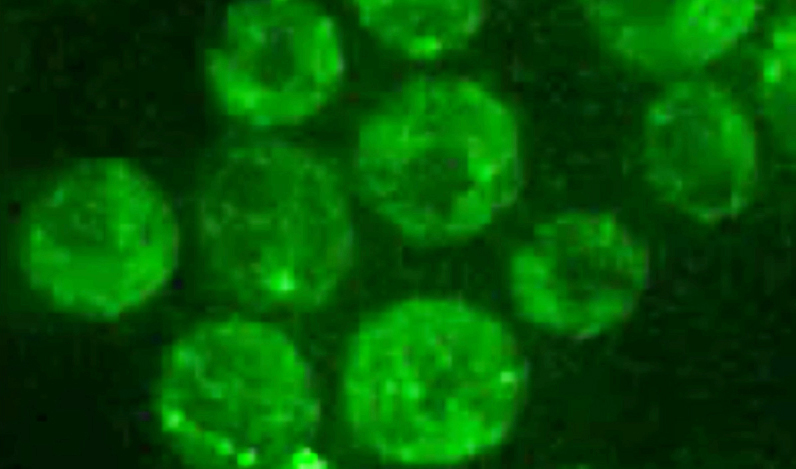
Marked in green: RNP granules in yeast cells. They form when cells are stressed using heat.
P bodies and stress granules are grain-like, membrane-less structures that can barely be seen with the microscope. They form when a cell experiences stress, like heat or other harsh conditions, and responds by adjusting the production of protein-encoding RNAs. RNAs not used under such stressful conditions are stored in stress granules or degraded in P bodies. This enables a cell to free capacities for the production of proteins that promote survival during stress. Both structures are suspected to be precursors of RNA-protein aggregates, which can be seen in the brains of patients with neurodegenerative diseases. These aggregates are very solid structures that hardly dissolve. Up to this date, the material state of P bodies and stress granules in healthy cells was still unclear. Researchers at the Max Planck Institute of Molecular Cell Biology and Genetics (MPI-CBG) now analyzed them and, to their surprise, found that P bodies and stress granules form very dynamic structures that do not have anything in common with the aggregates seen in disease conditions. (eLife, 4 August 2015)
Aggregates of otherwise soluble proteins can be found in the brains of patients with amyotrophic lateral sclerosis (ALS) – a disease that became commonly known through the „Ice Bucket Challenge“ and the movie about the life of the physicist Stephen Hawking. A proposed reason for the proteins to aggregate is long-lasting stress or mutations within specific proteins.
However, these proteins are also present in healthy cells, often in so-called P bodies and stress granules. „We wanted to know how these tiny structures form and if their normal structure is related to that seen in disease tissue“, explains Sonja Kroschwald, postdoc and first author of the study – this is how it started.
RNP granules are more dynamic in healthy cells
The research team used chemicals that can distinguish between liquid-like and solid-like structures to analyze the material state of P bodies and stress granules in cells. They could show that both P bodies and stress granules form much more dynamic assemblies than the pathological aggregates often seen in patients. They also found that P bodies rather behave like liquid droplets, while stress granules are more solid structures that are subject to a control system consisting of chaperones. These chaperones regulate the disassembly of stress granules and allow the cell to recover from previous stress.
While these observations were done in yeast cells, research group leader Simon Alberti and his team found that P bodies and stress granules have different properties in human cells, where they both show rather liquid-like behavior. „This means that the properties and the formation of these structures can be extremely different in various organisms“, says Alberti. “It also suggests that these RNA-protein granules can undergo some kind of structural transformation that is associated with disease.”
Future studies will investigate whether the ability to form more solid structures provides extra protection to yeast cells under conditions of extreme stress. Moreover, the Dresden researchers want to learn more about whether and how P bodies and stress granules turn into pathological aggregates seen in neurodegenerative diseases.
Sonja Kroschwald, Shovamayee Maharana, Daniel Mateju, Liliana Malinovska, Elisabeth Nüske, Ina Poser, Doris Richter, Simon Alberti: Promiscuous interactions and protein disaggregases determine the material state of stress-inducible RNP granules eLIFE, 4 August 2015
doi: 10.7554/eLife.06807